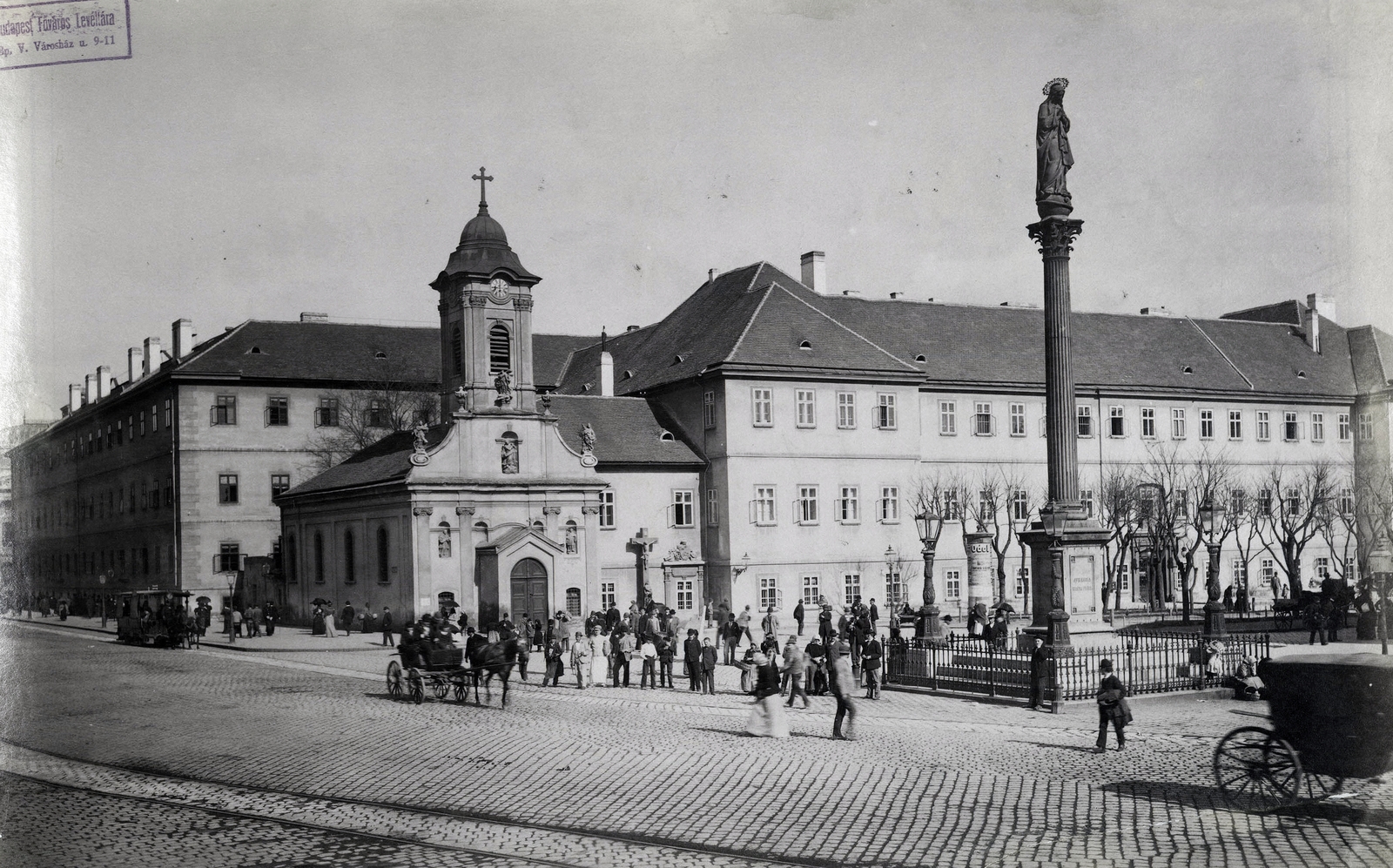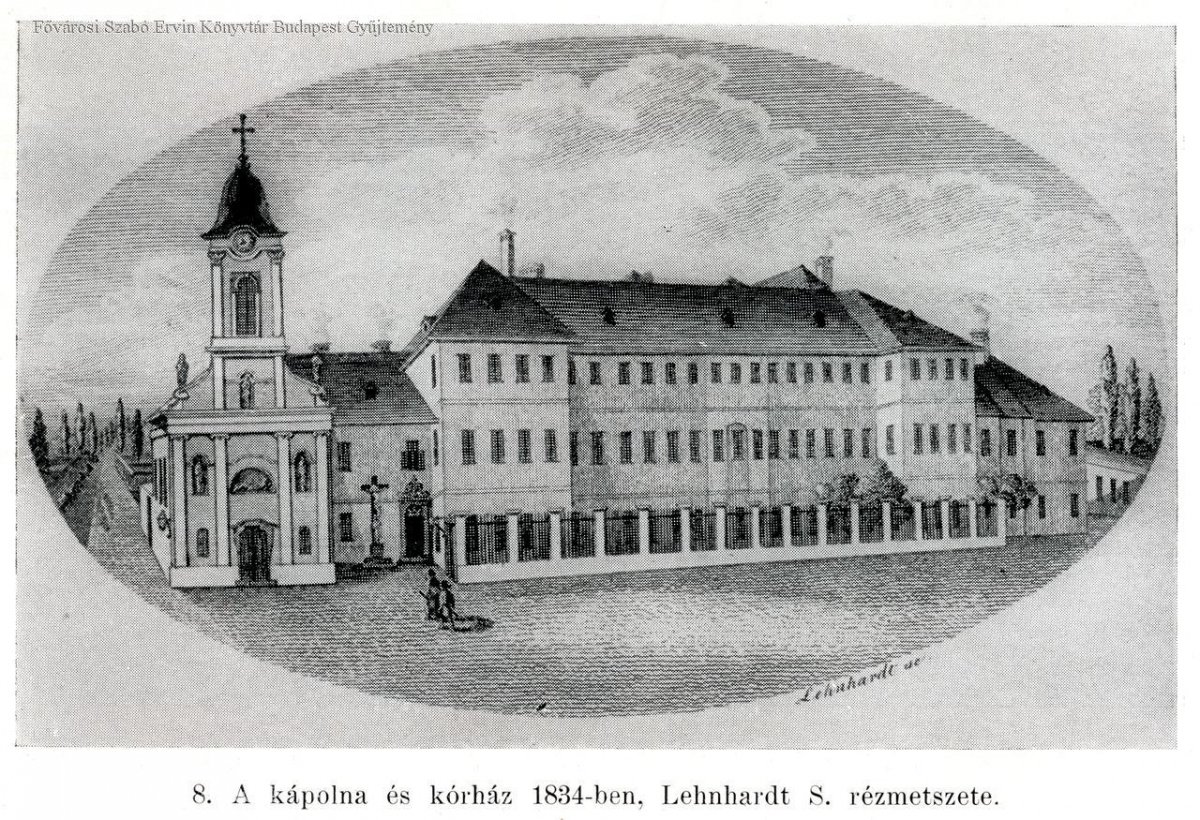At the beginning of the 1870s, Budapest only existed on paper, but the city leaders were already planning extensively for the new city created by the merger. The possibilities were limitless, since the goal was clear, small towns had to be created into a unified, large metropolis in a relatively short time. The government, the city management and the newly established Budapest Public Works Council, which managed the city's priority developments, were also united in this.
The development mostly affected empty or rather rural areas on the outskirts of the city, since the planned Outer Ring Road and Sugárút [Avenue] ran in such places, but there were also ideas for which existing institutions with a long history would have been sacrificed. One such proposal would have condemned the Rókus Hospital, which operated as one of the oldest hospitals in Pest on the outskirts of the city at the time, to demolition.
 The Rókus Hospital and its surroundings in 1870 (Source: FSZEK Budapest Collection)
The Rókus Hospital and its surroundings in 1870 (Source: FSZEK Budapest Collection)
In 1872, representative Endre Tavasy submitted his proposal for demolition to the Pest city council, and it was decided very quickly, as reported in the 8 August 1872 edition of the Pesti Napló:
"Representative Endre Tavaszy's proposal regarding the removal of the Rókus Hospital was accepted and the committee under the chairmanship of Councilor Gerlóczy, consisting of Hamza, Havas, Déry, Mezey, Tavaszy, Vecsey, DiBcher, Hatzenberger, Becker, Széher, Királyi, Sztupa, Csengey, Incze, Géza Halász, chief medical officer dr. Rókus Hoffmann, hospital director, a member of the accounting department and accountant Gyula Kun was dispatched in this matter."
All this on the day when the director of the Rókus Hospital warned the city council that the cholera epidemic was approaching Hungary.
Why did it came up to abolish this institution with a long history that was actually at the forefront of medicine in Hungary? In this hospital, the surgeon Ferenc Flór was the first to use the method of anaesthesia with diethyl ether and chloroform in patients undergoing surgery, and in 1851, Ignác Semmelweis in gynaecology used chlorine hand washing between two examinations, as well as regular bed linen changes and cleaning, which reduced the incidence of puerperal fever to less than 1 percent.

The hospital in the 1890s in a photo by Gyürgy Klösz (Fortepan / Budapest Archives. Reference No.: HU.BFL.XV.19.d.1.07.05)
The hospital was a real public hospital, with 678 beds at that time, which no longer functioned as a poor house, but as a real treatment centre that can be understood in today's sense. (In the 19th century, it was still quite common for those who could, to heal at home, hospitals were more of a kind of poor houses). The hospital was commissioned in 1798 and expanded several times over the next 70 years. However, by the beginning of the 1870s, the hospital proved to be cramped, beds were already placed in the middle of the wards, and expansion was constantly on the agenda.
The city representatives decided to close the Rókus precisely because in the 19th century the role of hospitals changed. They became more and more a field of real healing, they were built according to different principles, where infectious patients were physically separated from non-infectious patients. The representatives were aware that the city's hospital capacity is low, especially if another epidemic hits the increasingly crowded city. Therefore, they thought more about building new, modern hospitals. On 10 August 1872, a journalist from the Fővárosi Lapok wrote the following about Rókus, when he compared its condition with the relatively new Asylum of Lipótmező, handed over in 1868:
"And if the visitor remembers the obsolescence of the unsanitary Rókus Hospital, he will find such a difference between the two places that in the name of health and love of humanity, he would almost be willing to take a pickaxe to the old walls of the Rókus Hospital."
There was also an offer for the Rókus and the new hospital, the following small news appeared in the 4 September 1872 edition of the Budapesti Közlöny:
A consortium will make an offer to the city of Pest for the Rókus hospital. According to this, it declares that it is ready to build a large hospital modelled on the famous Leipzig hospital in a place to be designated by the city for the transfer of the hospital building and land. They want to turn Rókus Hospital into an apartment building."
It is a fact that something had to be done with Pest health care. In this year, 1872, a smallpox epidemic also devastated the city, despite the fact that the smallpox vaccine was already available, but few people received it, and in 1872 the cholera epidemic broke out again.

The tower house dreamed to replace Rókus (Magyar Építőművészet, 1928 No. 5–6)
However, the Rókus remained. In the following years, many new hospitals were built in Budapest based on the principles that were considered modern at the time. The old, aged hospital also kept pace with development, in 1875 infectious patients were separated, and when Franz Joseph visited the institution in 1876, he found everything in order. It also kept up with technical development, a good example of this is that this hospital was the first to use X-rays - 2 years after its invention.
In the following decades, the old building was threatened a few more times. In 1928, Hugó Gregersen designed a 34-story tower block to replace the hospital. The hospital was also in danger during the construction of the subway, because an experimental tunnel was built near the hospital during the suspension of subway construction between 1953 and 1963 to test a new soil consolidation method. Due to the unsuccessful attempt, the hospital was also in danger, but luckily no tragedy occurred. Rókus Hospital was last completely renovated and expanded between 1978 and 1991.
Cover photo: The Rókus Hospital in the 1830s (Source: FSZEK Budapest Collection)



































